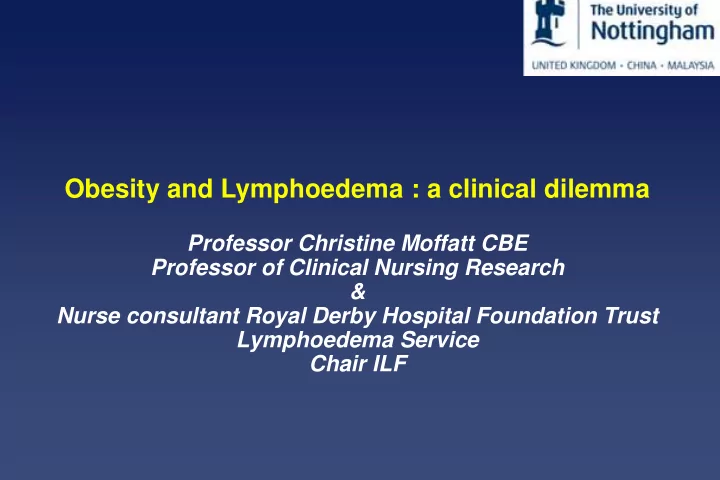

Obesity and Lymphoedema : a clinical dilemma Professor Christine Moffatt CBE Professor of Clinical Nursing Research & Nurse consultant Royal Derby Hospital Foundation Trust Lymphoedema Service Chair ILF
Outline of session The growing epidemic of obesity The link of obesity to lymphoedema Professional attitudes and challenges to care delivery Diagnostic imperatives and assessment challenges Psychosocial issues Towards effective care
The growing epidemic of obesity
The epidemic of obesity Health and Social Care Information Centre (2016) Increase in obesity from 15% in 1993 to 26% in 2014 Common co-morbidities Cardiovascular disease Hypertension Type 2 diabetes Sleep apnoea Depression Reduced mobility
The relationship of Lymphoedema and obesity Lymphoedema threshold with BMI Strong association with all forms of lymphoedema and obesity BMI 50/60kg/m 2 - lymphoedema Irreversible damage to lymphatics (Greene et al 2015)
Patients with Chronic Oedema (n=9,391) N % Primary lymphoedema 1413 15% Secondary 7904 84% lymphoedema Undefined 74 1% Lymphoedema only 7842 84% Lymphoedema & Other 1475 16% 13% Wound Midline 10% Morbidly obese 1609 18% Obese 3124 34% Normal weight 4166 46% Lower Limb Under weight 189 2% Upper 58% Limb 19% Cellulitis 3219 34% Infection 1330 14%
Determinants of HRQoL (EQ5D) n Mean SD p Female 761 63,6 20,0 0.001 Male 133 56,5 22,1 Lymphoedema only 818 63,3 20,1 <.001 Lymphoedema & wound 76 53,9 23,0 Morbidly obese 60 52,7 20,2 Obese 280 61,2 20,1 <.001 Normal weight 528 64,6 20,2 Under weight 25 56,3 22,1 No cellulitis 672 63,9 20,3 <.001 Cellulitis 222 58,2 20,4
Community Nursing Prevalence and Risk Factors N % • Clinical service (p=0.024) Nott 548 51.6 % • Age (p=<0.001) City • Ethnicity (p=<0.001) Nott 124 68.5 % • Obesity (p=<0.001) West • Heart failure/ CHD Leices 768 59.2 % (p=<0.001) ter City • Wound ( p=<0.001) 70% have a concurrent wound
The impact of chronic oedema on community nursing • 3.99 per 1000 population • 30/1000 in those aged over 85 years • Strong association with Age Reduced mobility Obesity Long term disability Leg ulceration
The link of obesity to lymphoedema
Why does obesity lead to Lymphoedema • Mechanisms are not clear • Adipose tissue and lymphatic failure • Reduced lymphatic transport • Obstruction to flow • Inflammation and cellulitis are highest in morbid obesity • Further destruction of lymphatics • Reduced function • Gravitational effects of sitting on capillary filtration • Inability to lose weight
Professional attitudes and challenges to care delivery
Professional attitudes to obesity • Professional beliefs that obesity is due to laziness or lack of willpower • Patients are time consuming physically and emotionally for professionals • Considered “difficult “ changes professional behaviour • Danger of blaming treatment failure on the patient • Coping with patients emotional distress • Evidence that CDT is more complex and results are not sustained • Lack of guidance on how to manage
Challenges to care delivery • Treatment often takes two therapists • Concerns over safety in metabolically unstable patients • Traditional approaches to CDT fail • Issues of manual lymphatic drainage • Inability to find appropriate compression • Inability to discharge patients to the community • Some services refuse to treat bariatric patients • Requirement for multi-professional teams • Link to bariatric services
Diagnostic imperatives and assessment challenges
Diagnostic challenges (medical issues) Cardiac status • Check for concurrent heart function • BNP blood test • If abnormal echocardiogram Renal function Liver Function Functional status and ability to manage treatment Concurrent diabetes Cellulitis / chronic wounds
Aspects of medical assessment • Identify the underlying cause of oedema • Optimise medication • Correct use of diuretics • Drugs associated with oedema • Recurrent cellulitis • Heart failure • Active and recurrent cancer
Assessment challenges • Understanding patients beliefs about the link to obesity and lymphoedema • Psychological status • Life style issues • Patient support systems • History of obesity and lymphoedema • Experiences of CDT treatment • Identifying patient goals for outcome • Exploring attitudes to bariatric surgery
Therapy assessment • Assessment of swelling • Pitting oedema • Tissue changes • Circumference measures • Lymphorrhoea • Signs of cellulitis/use of antibiotics • Wounds • Distribution of swelling • Limb shape distortion • Neuropathy
Psychosocial issues • Depression assessment • Pain assessment • Coping mechanisms • Social support and link to treatment • Unhealthy family/partner relationships • Adherence / concordance to treatment • History of relationships with professionals
Towards effective care
Managing the skin (1)
Managing the skin (2) • Skin hygiene • Control of mycosis • Control of bioburden • Use of emollients • Control of hyperkeratosis • Treatment of eczemas • Control of Lymphorrhea • Avoidance of maceration • Correct choice of wound dressings
Managing the skin (3)
Assessment and management of cellulitis Chronic oedema associated with cellulitis 50% of patients have recurrent cellulitis Systemic symptoms often require IV antibiotics Often associated with mycosis and poor skin hygiene Antibiotics required for several weeks/prophylaxis
Planning CDT • What is the goal of treatment? • How realistic is full CDT for the patient? • What service constraints influence treatment? • How will the patient cope with compression? • How much fluid will be moved during CDT? • How will the patient cope at home? • How will the outcomes be maintained? • How will intensive treatment be followed by maintenance treatment? • Can the patient reduce weight?
Progressive chronic oedema of the foot
Chronic oedema in the community
The challenges of adapting compression • Inadequate pressure due to size of limb • Compression adaption in extreme shape distortion • Managing foot and toe swelling • The dilemma of below vv full compression • Difficulties in donning and doffing compression garments • Using compression wraps • Prevention of rebound oedema • Patient factors that influence success
Full leg compression
Other strategies for care • Exercise • Elevation • Social care • Psychological support • Pain management • Bariatric referral
Its really difficult and often discouraging for the patient and professionals
Thank You
Recommend
More recommend